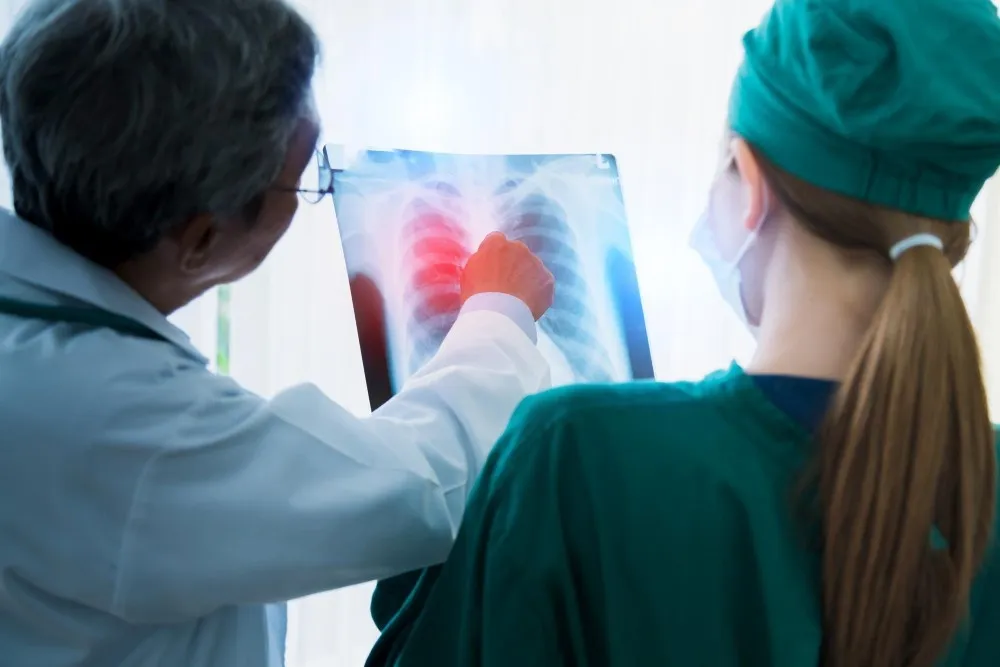Lung cancer affects a wide population. There were an estimated 2.21 million new cases worldwide in 2020. Despite how common lung cancer is, many people aren't aware of how it occurs or how to prevent it.Cells that line the air passages in the tissues of the lungs grow and multiply uncontrollably with lung cancer. This metastasizing often occurs throughout the lymphatic system. It produces lymph, a clear fluid that our body drains from our tissues and has immune cells which fight infection. The lymph nodes are small, bean-shaped organs that primarily trap cancer cells when they spread to the lymphatic system.
Lung Cancer Symptoms
The signs of lung cancer do not usually present unless the disease is in later stages. In the early stages of lung cancer, lung cancer symptoms can show up differently depending on your individual diagnosis. You could experience:- Persistent coughing
- Unexplained weight loss
- Sudden shortness of breath during everyday activities
- Hoarseness or wheezing
- Loss of appetite
- Fatigue
- Chronic lung infections
- Chest, shoulder, and back pain worsened by coughing, laughin, and deep breathing
- Coughing that produces blood
- Jaundice
- Facial, arm, or neck swelling,
- Lumps in the collarbone or neck
- Headaches, dizziness, or overall weak or numb limbs
- Bone pain
Risk Factors to Consider
There are several risk factors that cause lung cancer. You should keep these in mind to reduce your likelihood.Smoking
The rates of tobacco smoking have decreased since researchers linked it to lung cancer. In October, U.S. News reported that there were "new findings [that] underscore the power of quitting as early as possible." Researchers followed over 400,000 Americans and concluded that "smokers died of cancer at three times the rate of nonsmokers." They also discovered that "smokers who managed to quit by age 45 lowered that excess risk by 87%," and quitting by age 35 practically erased the risk of lung cancer death.Asbestos
In combination with a long-term smoking habit, asbestos can exacerbate the risk for lung cancer, but most prominently asbestos exposure leads to mesothelioma. While not a lung cancer, pleural mesothelioma occurs in "the lining of the lungs, known as the pleural." Of the four types of mesothelioma cancer, 80-90% of diagnoses are malignant pleural mesothelioma. The symptoms between lung and mesothelioma cancer generally overlap. Doctors may misdiagnose mesothelioma for lung cancer, seeing shortness of breath, dry cough, and chest pain as signs of the latter.Radon
This invisible natural gas can seep into buildings through the decay of soil and rocks. In low ventilated areas, such as homes, radon produces the highest risk. Radon is a cancer-causing gas that can become trapped within buildings that are not properly inspected. The excessive levels of radon that your home can expose you to and you may inhale put you in danger of developing lung cancer.Also read: Lymphoma Cancer: Symptoms, Causes, TreatmentGenetics
Recently, the Baylor College of Medicine performed studies finding "18% of lung cancer cases are due to inherited genetic variants." The research examined "whole exome sequencing on germline (inherited) DNA from eight large-scale datasets, including 1,045 patients with a family history of lung cancer or early-onset cancer." The patients are among the most likely to harbor genetic risk variants.The research team was trying to identify "variants that have a relatively high impact on risk but occur at relatively low frequency."Studies often assess "lung cancer risk genes, but the function of those genes has not been well understood." The Baylor College of Medicine study "found that dysregulation or mutations in these candidate genes showed increased DNA damage, suggesting that their potential cancer-causing role might be due to genome instability at the DNA level."This creates a new perspective on genetics and lung cancer. It's one that will unlock treatments for these cancers by "understanding which variants cause increased DNA damage."Lifestyle
Lifestyle is another factor. Along with genetics and predeterminers, daily exposures, eating habits, and exercise are critical. Research proves that "certain lifestyle choices...can lower our risk for certain cancers." Along with this, researchers associate these choices with 18% of all cancer diagnoses in the U.S. Recognizing these lifestyle factors can provide steps for you to take to prevent lung cancer. Although genetics and certain exposures are unavoidable, other risk factors are contributors.Lung cancer awareness is heightened during the winter months because of an increase in respiratory infections and diseases. Doing annual check-ups and monitoring your health can help catch cancer early on for an improved lung cancer prognosis. Thanks to continued research and advanced treatments, the rates of lung cancer are decreasing. Today, there is more assurance that lung cancer patients can receive the support they need to recover. If you want to know about lung cancer or their symptoms, prevention and treatment then you may consult in Rabindranath Tagore Hospital Kolkata.
Reviewed by







